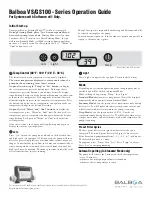
78
In comparison to non-flammable refrigerants, the fol-
lowing points must
additionally
be observed when
topping up flammable refrigerants:
■
Do not use the same fill valve for different refriger-
ants.
■
Position refrigerant bottles vertically.
■
Ensure the connection hoses are as short as possi-
ble, to keep the amount of refrigerant they contain as
small as possible.
Before commencing work, observe the "Checklist for
maintenance work" on page 60.
1.
Isolate the system from the power supply.
2.
Check whether the safety instructions for work on
the refrigerant circuit are being adhered to: See
page 3.
3.
Earth the refrigerant circuit.
4.
Carry out a pressure test with nitrogen.
5.
Fill the refrigerant circuit with refrigerant.
Danger
An excessive refrigerant charge leads to a
risk of explosion.
Do not overfill the refrigerant circuit: For
refrigerant charge see "Specification".
6.
Affix a label to the heat pump in a clearly visible
position, containing the following information, with
date and signature:
■
Type of topped up refrigerant
■
Amount of topped up refrigerant
7.
Carry out the tightness test using an explosion-
proof refrigerant detector suitable for R290.
8.
Seal the sealing cap of the low pressure Schrader
valve: See pos.
M
in fig. 38 on page 76.
Draining the heat pump on the primary/secondary side
1.
Shut off the connection to the heating network.
2.
Drain the heat pump at the primary/secondary side
drain valve: See page 75.
The appliance is too noisy
Possible causes:
■
Transport bracket not removed
Installation and dismantling instructions
"Vitocal 300-G, type BW 301.C17"
■
Hose outlets in diaphragm grommets are not tight:
See page 79.
■
Casing door is not closed tight: See page 74.
Condensation and humidity in the heat pump module
Possible causes:
■
Hose outlets in diaphragm grommets are not tight:
See the following chapter.
■
Casing door is not closed tight: See page 74.
■
Outer panels not closed diffusion-proof: See
page 64.
Maintenance
Topping up the refrigerant
5800 917 GB
Maintenance
















































